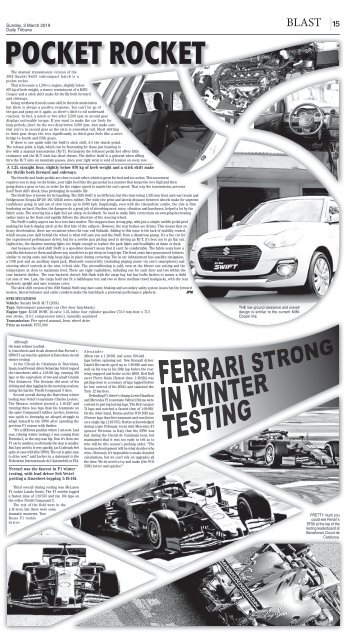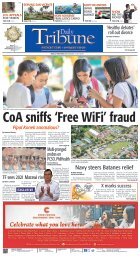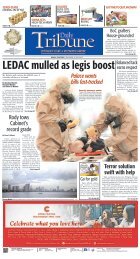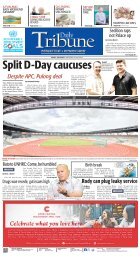03 MARCH 2019
Create successful ePaper yourself
Turn your PDF publications into a flip-book with our unique Google optimized e-Paper software.
Sunday, 3 March <strong>2019</strong><br />
Daily Tribune<br />
BLAST<br />
15<br />
POCKET ROCKET<br />
The manual transmission version of the<br />
<strong>2019</strong> Suzuki Swift subcompact hatch is a<br />
pocket rocket.<br />
That is because a 1,200 cc engine, slightly below<br />
870 kg of kerb weight, a stance reminiscent of a MINI<br />
Cooper and a stick shift make for thrills both forward<br />
and sideways.<br />
Going northward needs some skill in throttle moderation<br />
but there is always a positive response. You can’t let go of<br />
the gas and jump on it again, as there’s little to nil northward<br />
reaction. In fact, a notch or two after 2,500 rpm in second gear<br />
displays noticeable torque. If you want to make the car lively for<br />
long periods, don’t let the revs drop below 3,000 rpm. Just make sure<br />
that you’re in second gear as the ratio is somewhat tall. Short shifting<br />
to third gear drops the revs significantly as third gear feels like a mere<br />
bridge to fourth and fifth gears.<br />
If there is one quirk with the Swift’s stick shift, it’s the clutch pedal.<br />
The release point is high, which can be frustrating for those just learning to<br />
live with a manual transmission (M/T). Fortunately the leftmost pedal feel offers little<br />
resistance and the M/T stick has short throws. The shifter itself is a godsend when rifling<br />
thru the M/T slots on mountain passes, since your right wrist is void of tension on every row.<br />
A 1.2L straight four, slightly below 870 kg of kerb weight and a stick shift make<br />
for thrills both forward and sideways.<br />
The throttle and brake pedals are close to each other, which is great for heel-and-toe action. This movement<br />
requires you to step on the brake, your right heel hits the gas pedal in a manner that keeps the revs high and then<br />
going down a gear or two, in order for the engine speed to match the car’s speed. That way the transmission prevents<br />
itself from shift shock, thus prolonging its useable life.<br />
The Swift line is known for its handling. The <strong>2019</strong> Swift is no different, but this time toting 1,520 mm front and rear treads and<br />
Bridgestone Ecopia EP150 185/55R16 series rubber. The wide tire print and lateral distance between wheels make for supreme<br />
confidence going in and out of slow turns up to 80-90 kph. Surprisingly, even with the rim-and-tire combo, the ride is firm<br />
bordering on hard. Further, the dampers do a great job of absorbing most noise, vibration and harshness, helped a lot by the<br />
fabric seats. The steering has a light feel yet sharp on feedback. No need to make little corrections on sweeping decreasing<br />
radius turns as the front end rapidly follows the direction of the steering wheel.<br />
The Swift’s safety aspect can be a love-hate matter. The stoppers have strong grip, with just a simple middle pedal prod<br />
making the hatch display pitch at the first bite of the calipers. However, the rear brakes are drums. This means that on<br />
heavy deceleration, there are occasions when the rear end fishtails. Adding to this issue is the lack of stability control,<br />
which means your skill behind the wheel is what will save you and the Swift from a disastrous prang. It’s a fun car for<br />
the experienced performance driver, but for a newbie just getting used to driving an M/T, it’s best not to go flat out.<br />
Lights-wise, the daytime running lights are bright enough to replace the park lights and headlights at dawn or dusk.<br />
Just because the stick shift Swift is a speedster doesn’t mean that it can’t be comfortable. The fabric seats have a<br />
sofa-like thickness to them and allows any non-driver to get sleep on long trips. The front seats have pronounced bolsters<br />
similar to racing seats and help keep hips in place during cornering. The in-car infotainment has satellite navigation,<br />
a USB port and an auxiliary input jack, Bluetooth connectivity (including playing music via one’s smartphone) and<br />
steering wheel controls at the nine o’clock side. The airconditioning is cold, even at the blower one setting and the<br />
temperature at close to maximum level. There are eight cupholders, including one for each door and two within the<br />
rear backrest divider. The rear backrest doesn’t fold flush with the cargo bay but has Isofix latches to mount a child<br />
car seat or two. Last, the cargo hold can fit a balikbayan box and two to three medium travel backpacks, with the rear<br />
backrests upright and sans tonneau cover.<br />
The stick shift version of the <strong>2019</strong> Suzuki Swift may have some braking and secondary safety system issues but the forward<br />
motion, lateral behavior and cabin comforts make the hatchback a potential performance platform.<br />
JPM<br />
SPECIFICATIONS<br />
Vehicle: Suzuki Swift M/T (<strong>2019</strong>)<br />
Type: Subcompact passenger car (five door hatchback)<br />
Engine type: K12M DOHC 16-valve 1.2L inline four cylinder gasoline (73.0 mm bore x 71.5<br />
mm stroke, 11.0:1 compression ratio), naturally aspirated<br />
Transmission: Five speed manual, front wheel drive<br />
Price as tested: P755,000<br />
THE low ground clearance and overall<br />
design is similar to the current MINI<br />
Cooper line.<br />
Although<br />
the team refuses to admit<br />
it, timesheets and rivals deemed that Ferrari’s<br />
SF90 F1 car was the quickest in Barcelona circuit<br />
winter testing.<br />
At the Circuit de Catalunya in Barcelona,<br />
Spain, lead Ferrari driver Sebastian Vettel topped<br />
the timesheets with a 1:18:161 lap, running 160<br />
laps or the equivalent of two-and-a-half Grands<br />
Prix distances. The German did most of his<br />
driving and data logging in the morning sessions,<br />
using the harder Pirelli Compound 3 tires.<br />
Second overall during the Barcelona winter<br />
testing was Vettel’s teammate Charles Leclerc.<br />
The Monaco resident posted a 1:18:247 and<br />
running three less laps than his teammate on<br />
the same Compound 3 rubber. Leclerc, however,<br />
was quick to downplay an alleged struggle to<br />
adapt himself to the SF90 after spending the<br />
previous F1 season with Sauber.<br />
“It’s a different position where I am now. Last<br />
year, (during winter testing), I was coming from<br />
Formula 2, so the step was big. Now it’s from one<br />
F1 car to another, so obviously the step is smaller.<br />
But I got used to it very quickly, (as I) already feel<br />
quite at ease with (the SF90). The car is quite easy<br />
to drive now,” said Leclerc in a statement to the<br />
Federation Internationale de l’Automobile or FIA.<br />
Ferrari was the fastest in F1 winter<br />
testing, with lead driver Seb Vettel<br />
posting a timesheet-topping 1:18:161.<br />
Alexander<br />
Albon ran a 1:19:301 and some 100-odd<br />
laps before spinning out. New Renault driver<br />
Daniel Ricciardo sped up to 1:19:886 and was<br />
well on his way to his 29th lap before the rear<br />
wing snapped and broke on his RS19. Red Bull<br />
racer Pierre Gasly (fastest time: 1:19:814) was<br />
getting close to a century of laps logged before<br />
he lost control of his RB15 and smacked the<br />
Turn 12 barriers.<br />
Defending F1 driver’s champ Lewis Hamilton<br />
and Mercedes F1 teammate Valtteri Bottas were<br />
content to just log testing laps. The Brit ran just<br />
74 laps and notched a fastest time of 1:19:928.<br />
On the other hand, Bottas and his W10 <strong>2019</strong> ran<br />
20 more laps than his teammate and was faster<br />
on a single lap (1:19:535). Bottas acknowledged<br />
during a late February event with Mercedes F1<br />
sponsor Petronas in Italy that the SF90 was<br />
fast during the Circuit de Catalunya tests, but<br />
maintained that it was too early to tell as to<br />
who will be this season’s pecking order. “The<br />
in-season development will be what decides who<br />
wins. Obviously it’s impossible to make detailed<br />
calculations, but we can’t rely on upgrades all<br />
the time. We do need to try and make (the W10<br />
<strong>2019</strong>) better and quicker.”<br />
Third overall during testing was McLaren<br />
F1 rookie Lando Norris. The F1 newbie logged<br />
a fastest time of 1:18:553 and ran 104 laps on<br />
the softer Pirelli Compound 2.<br />
The rest of the field were in the<br />
1:19 level, but there were some<br />
dramatic moments. Toro<br />
Rosso F1 rookie<br />
driver<br />
PRETTY much you<br />
could see Ferrari’s<br />
SF90 at the top of the<br />
testing leaderboard at<br />
Barcelona’s Circuit de<br />
Catalunya.


















